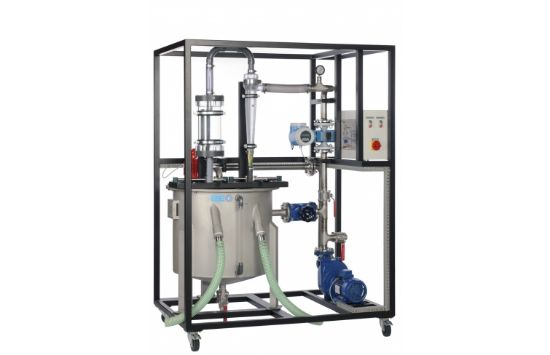The GUNT Hydrocyclone Separation Trainer demonstrates the principles of solid-liquid separation using centrifugal forces. Developed in collaboration with the Department of Mechanical Process Engineering at Anhalt University of Applied Sciences, the unit features a tangential inlet to induce a primary vortex, enabling effective separation of coarse and fine particles. Ideal for teaching separation efficiency and cut size determination, the system includes flow control and sampling points for comprehensive data collection.
Product Features
- Hydrocyclone setup for solid-liquid separation using centrifugal vortex
- Suspension prepared in a tank and delivered via pump to the cyclone’s tangential inlet
- Formation of a downward primary vortex and reversing secondary vortex within the cyclone
- Coarse solids enriched in the primary vortex and discharged at the apex (underflow)
- Fine material exits through the vortex finder at the top (overflow)
- Air core formation in the cyclone supports separation process
- Inlet flow rate adjusted via bypass valve and measured by electromagnetic flow meter
- Sampling points provided at both underflow and overflow outlets
- Manual measurement of outlet flow using bucket and stopwatch
- Balance and drying chamber recommended for solid concentration determination
- Supports use of quartz powder and diatomite as test solids
- Separation function and cut size can be analyzed using diffraction spectrometer
- Designed for educational and research applications in process engineering
Benefits
- Hands-on demonstration of centrifugal separation in fluid mechanics
- Visualizes and quantifies separation performance using practical sampling and measurement
- Reinforces theoretical understanding with real-world equipment and process control
- Suitable for studying cut size and particle distribution curves
- Promotes competency in using flow measurement and particle analysis tools
Why Choose the GUNT Hydrocyclone Trainer?
The GUNT Hydrocyclone Trainer provides a practical and analytical platform for teaching solid-liquid separation. From flow rate control to particle cut size analysis, the system delivers a comprehensive learning experience. Built in collaboration with academic experts, it is the ideal tool for teaching separation processes in mechanical and chemical engineering curricula.

